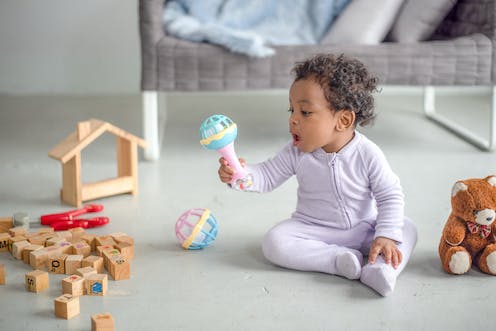
Tech toys may claim to be educational – but those claims often aren’t backed by science. boonchai wedmakawand/Moment Collection/Getty Images
Picking out a baby toy – whether it’s for your own child or a friend’s kid or the child of a family member – can be overwhelming. Although Americans spend US$20 billion a year on baby toys, it’s difficult to know which toy will be fun, educational and developmentally appropriate. The options seem endless, with search results at common retail sites in the hundreds, if not thousands. Is price a reliable indicator of quality? Are technological enhancements useful?
Our peer-reviewed study – published in the American Journal of Play in April 2023 – surveyed the toy market for babies and toddlers age 0-2 at two major U.S. national retailers, with an eye toward differences between battery-powered toys, like the LeapFrog Speak and Learn Puppy, and traditional toys, such as the Magic Years Jungle Finger Puppet.
We found significant differences between these two toy types in terms of how they’re marketed – with more traditional toys marketed as supporting physical development and more technological toys aimed at cognitive development. However, these companies do not always have researchers investigating whether the toys actually help children learn.
As researchers who study toys and how children learn and play, we offer five tips before you buy your next baby toy.
1. Consider your goal
When purchasing a toy, consider whether you have any particular developmental goal in mind. For instance, do you want your baby to develop fine motor skills by playing with a busy board, or to practice spatial skills by building a block tower?
2. Look for open-ended toys
Many parents and caregivers know that children often love playing with the box more than the toy inside it. One reason is that boxes are open-ended toys – they can become anything a young child dreams up. Conversely, a toy cellphone directs the type of play much more rigidly.
A good rule of thumb is to choose toys that require 90% activity from the child and only about 10% input from the toy. For example, infants can explore a set of realistic miniature animals sensorially – usually by putting them in their mouths – and then later use them for pretend play, or even to create animal footprints in play dough. Contrast this experience with a large plastic elephant that needs to sit on the floor and lights up and makes elephant sounds. Here, a child is limited in play, with the goal being to make the object light up or play a sound.
Parents tend to talk to kids more when they play together with traditional toys versus tech toys.
iStock / Getty Images Plus
3. Recognize gender biases
Several major retailers have removed gender-based toy sections over the past decade, opting for “kids” instead of “boys” and “girls.”
However, if you enter the store of one of those major toy retailers today, you will still find some aisles filled with pink toys and dolls, while other aisles feature monster trucks and primary-colored blocks. A toy sword might not be labeled as “for boys,” yet shoppers often perceive it that way based on their own gender socialization and beliefs. If you look only in certain aisles or at stereotypical toys, you might miss out on toys that your child would enjoy regardless of gender.
4. Be wary of marketing claims
The makers of tech toys often make claims about their educational potential that are not backed by science. For example, an electronic shape sorter might claim to help children develop emotional skills because the toy says “I love you!”
Be skeptical of such claims, and use your own experience and insights to evaluate the educational potential of a toy. You might read the retailer and manufacturer descriptions, but also see what the toy actually does. If it fosters caregiver-child interactions or helps to develop a specific skill – like how building blocks support spatial skills, and finger puppets build fine motor skills – then it is likely a toy worth considering.
5. Prioritize human interactions
Keep in mind that toys are not chiefly designed to create baby geniuses – they are meant to be fun! So think broadly about whether you want a new toy to support physical, social, emotional, cognitive or creative development while keeping it fun. And remember that no toy can replace joyful, high-quality interactions between caregivers and children.
Research suggests that caregivers are less responsive and communicative when playing with tech toys versus traditional toys with their children. So choosing traditional toys, such as nonelectronic shape sorters and building blocks, may be one way to foster the types of interactions that support healthy development.
Overall, research suggests that, in most cases, traditional toys provide better interactions and experiences than technological toys. When purchasing a toy, think through the experiences you want the baby in your life to have, think broadly about the goals of a particular toy, try to provide opportunities for high-quality interactions and remember to have fun.
Jennifer M. Zosh has consulted for the Lego Group.
Brenna Hassinger-Das does not work for, consult, own shares in or receive funding from any company or organization that would benefit from this article, and has disclosed no relevant affiliations beyond their academic appointment.
Advertisement

Advertisement
Contact Us
If you would like to place dofollow backlinks in our website or paid content reach out to info@qhubonews.com











